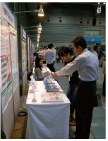|
 |
■ Bioresources information is available at the following URLs
|
 |
|
Report on Organizing International Conference
21st International Conference on Arabidopsis Research (ICAR2010)
Masatomo Kobayashi (Head of Experimental Plant Division, RIKEN BioResource Center)
International Conference on Arabidopsis Research (ICAR) and ICAR2010 held in Japan
Arabidopsis research has greatly progressed since the late twentieth century as a result of international cooperation. The Multinational Arabidopsis Steering Committee (MASC) has been a driving force behind this accomplishment and has hosted the ICAR, which presents the latest achievements in Arabidopsis research by the Arabidopsis researchers' community.
The 1st ICAR was held in Germany in 1965. Following the Arabidopsis genome analysis initiated by the international consortium, the ICAR has been almost annually organized in Europe or the US, as a venue for presenting research achievements and boosting exchanges among researchers. Moreover, Arabidopsis research became globally active in the twenty-first century, and thus, the ICAR began to be held annually on a rotational basis in each of the following three regions—Asia and Oceania, Europe, and North America. ICAR2010 was held in Yokohama, Japan, this year; this was the second time the ICAR was held in Asia and the first time in Japan. Staff members, primarily from RIKEN and other research institutions and universities, joined the organizing committee, and they along with the entire Arabidopsis research community were involved in the preparations for the event. |
Milestone Conference on Arabidopsis Research |

Photo 1:
ICAR2010 organized under the theme of "2010 and beyond" |
This was the final year of the "Arabidopsis 2010 Project," which was initiated in 2001. The project aimed at annotating functions to all the Arabidopsis genes and consolidating Arabidopsis resources and information for international collaboration. The project was highly successful; however, this post-genome Arabidopsis research project, which aims at analyzing gene functions, will be terminated. The challenge in Arabidopsis research for the next ten years will presumably be the conducting of cutting-edge research, such as non-coding RNAs and epigenetics in Arabidopsis, by utilizing its ample genomic information and transferring the previous findings from Arabidopsis studies to applied research. Thus, the organizing committee set "2010 and beyond" as the theme for ICAR2010 and invited speakers engaging in applied research to openly facilitate the exchange of views among plant research communities (Photo 1).
|
Organization and Achievements of ICAR2010 |
ICAR2010 was held at Pacifico Yokohama from June 6 to 10, and it drew 1,305 researchers from 32 countries, including Japan, making it the second-largest ICAR in history (Photo 2).
Over 900 presentations were delivered at ICAR2010 including invited lectures and posters, and they covered a wide range of research fields including systems biology and crop genomics. In addition, as a special session, the future of the Arabidopsis research community was discussed in the "2010 and beyond" session hosted by the National Science Foundation (NSF). Many participants formed groups and vigorously discussed topics over coffee between each session, signifying that the conference was very successful (Photo 3).
|
|

Photo 2 :
Plenary session organized at the main hall on June 7

Photo 3 : Participants having a discussion in the lobby during a break
|

Photo 4:
Participants being given an explanation at the NBRP exhibition booth |
The prominent event at this conference was the special exhibition of plant resources and information organized by the National BioResource Project (NBRP) and the head office, in order to facilitate information exchange between Arabidopsis researchers and crop researchers. The booth attracted a number of participants on the poster session days - June 7 and 8 (Photo 4). Furthermore, special poster presentations by the students of Super Science High School (SSH), including a poster presentation in English, and open lectures were also presented. Thus, we spent five highly intense and satisfying days.
|
Toward the Future of Plant Research
As previously noted, global Arabidopsis research has reached a turning point. The next ten years of Arabidopsis research will focus on ways to apply the previously accumulated resources, technologies, and information to crop and timber research. We hope that the researchers have taken the opportunity of participating in the ICAR2010 organized in Japan to further deepen their relationships with communities pursuing basic and applied sciences and those focusing on different model organisms or crops. ■ |
"translated by ASL translation service, and validated by the author" |
|
|
Let’s Easily Understand English on the Web!

What do you do when you visit an English website and find a word whose meaning you cannot remember? You might copy and paste the English word into an online dictionary to look up the meaning. However, this is a rather cumbersome task. I now introduce the life science dictionary (LSD) tool that enables us to efficiently look up English words in Firefox when we read English websites. |
What is the LSD tool?

The LSD tool (http://www.lsdtools.org/index_en.html) is a dictionary tool released by the Life Science Dictionary Project (http://lsd.pharm.kyoto-u.ac.jp/en/index.html)and is used to translate the life science terminology used in English websites. The LSD tool is specialized in translating life science terms from English to Japanese and vice versa, and it contains 93,000 English and 105,000 Japanese entries, including example sentences and related gene information. |
|

|
Installation

First, open the webpage,https://addons.mozilla.org/en-US/firefox/addon/12157,in Firefox and click on the "Continue to Download" button (Fig. 1). Next, follow the instructions appearing on the screen to complete the installation. (If the "Software Installation" window pops up, press the "Install Now" button to continue the process.) |
|

Fig. 1: Life Science Dictionary Tool
Firefox Add-on Website
|

The configuration of the LSD tool should be examined upon its installation. To do this, find the "LSD" item in the Firefox menu bar and check "LSD" in the drop-down menu if it is unchecked (Fig. 2). |
|

Fig. 2: Checking the Configuration of the LSD Tool |
Displaying English into Japanese Translations

Let us see the example of an English word translated into Japanese. Here, the journal article "NBRP databases: Databases of biological resources in Japan" has been used. Open the website, http://www.ncbi.nlm.nih.gov/pmc/articles/PMC2808968/, in Firefox. When the cursor is placed over an English word, the meaning and usage of the word is displayed in English and Japanese (Fig. 3). |
|

Fig. 3: Meaning and usage of the word "spontaneous" appearing in the article "NBRP databases: Database of biological resources in Japan." |

Finally, life science books are publicly available on the NCBI Bookshelf (http://www.ncbi.nlm.nih.gov/books). Therefore, please utilize the LSD tool when reading books that interest you from the NCBI website. (Tohru Watanabe) |
|
|